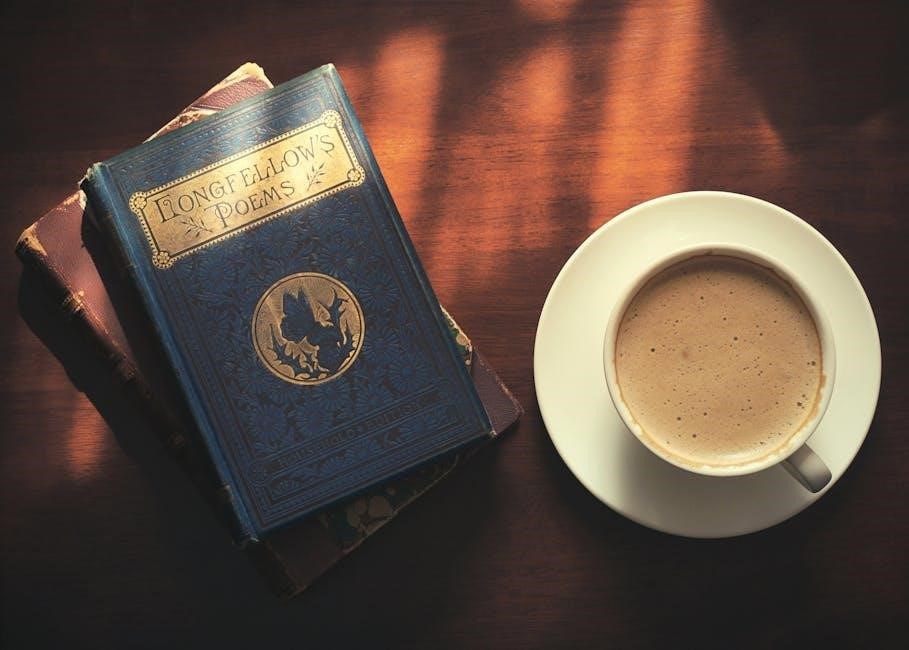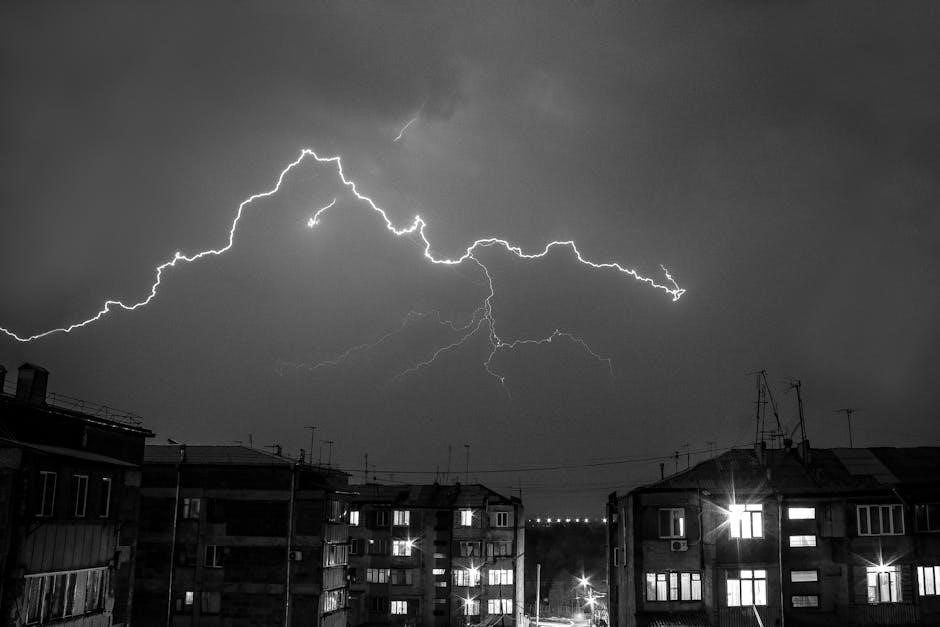The Charge of the Light Brigade by Alfred, Lord Tennyson, immortalizes the doomed cavalry charge at the Battle of Balaclava during the Crimean War, celebrating courage and sacrifice.
1.1 Overview of the Poem
The Charge of the Light Brigade, written by Alfred, Lord Tennyson, is a powerful narrative poem commemorating the ill-fated charge of British cavalry during the Battle of Balaclava in the Crimean War. Published in 1854, it vividly captures the valor and sacrifice of the soldiers, exploring themes of duty, obedience, and the tragic consequences of war, through its iconic lines and rhythmic structure.
1.2 Historical Context: The Crimean War and the Battle of Balaclava
The Crimean War (1853–1856) was a conflict between Russia and an alliance of France, Britain, and the Ottoman Empire, sparked by disputes over religious rights in the Holy Land. The Battle of Balaclava, fought on October 25, 1854, was a pivotal moment, marked by the ill-fated Charge of the Light Brigade, where 600 British cavalrymen advanced against heavily defended Russian positions, resulting in significant casualties and widespread outrage over military mismanagement.

The Poet: Alfred, Lord Tennyson
Alfred, Lord Tennyson was a renowned British poet and Poet Laureate during much of Queen Victoria’s reign, celebrated for his lyrical style and exploration of human emotion and morality.
2.1 Biography of Alfred, Lord Tennyson
Alfred, Lord Tennyson was born on August 6, 1809, in Somersby, England. He rose to prominence as a poet, becoming Poet Laureate in 1850, a position he held until his death in 1892. Tennyson is celebrated for works like In Memoriam A.H.H. and Idylls of the King. His poetry often explored themes of nature, morality, and human struggle. He was buried in Westminster Abbey, a testament to his enduring legacy.
2.2 Tennyson’s Role as Poet Laureate and His Style
Alfred, Lord Tennyson became Poet Laureate in 1850, a role he held until his death in 1892. His poetry, known for its harmonious style and reflective tone, often explored themes of duty, patriotism, and the human condition. Works like The Charge of the Light Brigade showcased his ability to capture the national mood, blending lyrical elegance with profound emotional depth, solidifying his legacy as a master of Victorian poetry.

The Event That Inspired the Poem
The Charge of the Light Brigade was inspired by the Battle of Balaclava during the Crimean War, where 600 British cavalrymen courageously charged against overwhelming odds on October 25, 1854.
3.1 The Charge of the Light Brigade: A Historical Account
The Battle of Balaclava on October 25, 1854, saw 600 British cavalrymen charge Russian forces due to misinterpreted orders. Despite heavy artillery fire, the Light Brigade advanced courageously, suffering significant casualties. This ill-fated event highlighted the bravery of the soldiers and the tragic consequences of battlefield miscommunication, inspiring Tennyson’s poem as a tribute to their sacrifice.
3.2 The Misinterpretation of Orders and Its Consequences
The Charge of the Light Brigade resulted from a critical misinterpretation of orders during the Battle of Balaclava. British cavalry received ambiguous instructions to capture Russian artillery, leading them to charge into a heavily defended valley. The confusion in command caused significant casualties, highlighting the tragic consequences of unclear communication in warfare, as immortalized in Tennyson’s poem.

Key Themes in the Poem
Courage and sacrifice are central, as the poem honors the bravery of the Light Brigade; It also explores duty, obedience, and the tragedy of war, emphasizing human cost and futility.
4.1 Courage and Sacrifice
Courage and sacrifice are central themes, as the poem glorifies the Light Brigade’s bravery despite overwhelming odds. Tennyson portrays the soldiers’ unwavering commitment to duty, even in the face of certain death. The famous lines, “Forward, the Light Brigade!” and “Theirs not to reason why, / Theirs but to do and die,” encapsulate their unyielding spirit and honor in sacrifice.
4.2 The Nature of Duty and Obedience
Tennyson’s poem explores duty and obedience through the soldiers’ unwavering commitment to orders, even when misinterpreted. The lines, “Theirs not to reason why, / Theirs but to do and die,” highlight their unyielding loyalty to command. This portrayal underscores the tragic consequences of blind obedience, emphasizing the human cost of following duty without question in the chaos of war.
4.3 The Tragedy of War and Human Cost
The poem vividly portrays the tragedy of war through the ill-fated charge of the Light Brigade. Tennyson captures the bravery of soldiers who rode into certain death, highlighting the devastating human cost of miscommunication and flawed leadership. The poem reflects on the futility of war, where noble sacrifice is overshadowed by the avoidable loss of life, leaving a lasting emotional impact on readers.
Poetic Elements and Structure
Tennyson’s poem employs a rhythmic meter and rhyme scheme, enhancing its epic and dramatic tone. The structure, with repeated phrases, builds momentum, mirroring the brigade’s doomed yet heroic charge.
5.1 The Use of Rhyme and Meter
Tennyson’s poem features a trochaic tetrameter rhythm, creating a galloping pace that mirrors the cavalry charge. The rhyme scheme, primarily ABAB, adds musicality and structure, enhancing the narrative’s dramatic and heroic tone. The meter’s steady beat underscores the urgency and inevitability of the brigade’s fate, while the rhyme contributes to the poem’s memorability and emotional resonance, heightening its epic and tragic qualities effectively.
5.2 Imagery and Symbolism in the Poem
Tennyson employs vivid imagery to depict the chaos and horror of war, such as “the valley of Death” and “jaws of Hell,” symbolizing the soldiers’ doomed fate. The “six hundred” represents noble sacrifice, while the misinterpreted orders and blundering leaders symbolize the tragedy of human error. These elements evoke deep emotional responses, emphasizing courage, duty, and the futility of war, creating a lasting impact on readers through powerful, enduring symbols that resonate universally.

The Publication and Reception of the Poem
The Charge of the Light Brigade was published in The Examiner on December 9, 1854. It quickly gained popularity, praising the soldiers’ bravery and sacrifice, resonating deeply with the Victorian public and becoming an iconic piece in British literature.
6.1 The Examiner Publication and Initial Response
The Charge of the Light Brigade was first published in The Examiner on December 9, 1854. The poem immediately struck a chord with the British public, evoking strong emotions and patriotism. Its vivid portrayal of courage and sacrifice resonated deeply, particularly during the Crimean War. The poem’s rhythmic and dramatic style, coupled with its tribute to the soldiers, contributed to its widespread acclaim and enduring popularity.
6.2 The Poem’s Enduring Popularity
The Charge of the Light Brigade remains a celebrated poem due to its powerful portrayal of courage, sacrifice, and the human cost of war. Its vivid imagery, rhythmic style, and universal themes continue to resonate with readers. The poem’s ability to honor the soldiers while critiquing authority ensures its relevance, making it a timeless piece in the literary canon.
The Significance of the Poem in Literature
The Charge of the Light Brigade stands as a landmark in war poetry, capturing the tragedy and heroism of conflict while influencing later works with its masterful style and themes.
7.1 Its Place in the Canon of War Poetry
The Charge of the Light Brigade is a cornerstone of war poetry, praised for its vivid imagery and emotional depth. Tennyson’s masterpiece captures the heroism and futility of war, resonating universally and influencing later poets. Its enduring themes of sacrifice and duty solidify its prominence in the literary canon, making it a timeless reflection on conflict and humanity.
7.2 The Poem’s Cultural and Historical Impact
The Charge of the Light Brigade deeply influenced British culture, shaping perceptions of the Crimean War. Its vivid portrayal of heroism and tragedy resonated with the public, immortalizing the sacrifice of the Light Brigade. Tennyson’s poem not only honored the soldiers but also critiqued the mismanagement of war, sparking discussions on duty and authority. Its legacy endures in literature, education, and popular culture, symbolizing both the glory and the futility of war.
Analysis of the Poem’s Famous Lines
The Charge of the Light Brigade features iconic lines like “Half a league, half a league, half a league onward,” capturing the relentless advance of the cavalry, while “Theirs not to reason why, theirs but to do and die” underscores the soldiers’ unwavering duty and sacrifice, embedding the poem in cultural memory.
8.1 “Half a League, Half a League, Half a League Onward”
“Half a league, half a league, half a league onward” opens the poem, establishing a rhythmic urgency that propels the narrative. This repetition emphasizes the relentless advance of the Light Brigade, creating a sense of inevitability. The phrase captures the cavalry’s determined movement into the “valley of Death,” setting the tone for the tragic yet heroic events that unfold, reflecting duty and sacrifice.
8.2 “Theirs Not to Reason Why, Theirs But to Do and Die”
“Theirs not to reason why, theirs but to do and die” encapsulates the soldiers’ unwavering obedience and acceptance of their fate. This line underscores the theme of duty, emphasizing that the soldiers’ role is to follow orders without question, even in the face of certain death. It reflects the tragic heroism and the futility of war, where sacrifice is expected without deliberation, highlighting the human cost of obedience and conflict.
The Charge of the Light Brigade in Modern Times
The Charge of the Light Brigade remains a powerful symbol of courage and sacrifice, frequently referenced in popular culture, literature, and education, ensuring its enduring relevance today.
9.1 The Poem’s Relevance Today
The Charge of the Light Brigade continues to resonate as a powerful exploration of duty, sacrifice, and the human cost of war. Its themes of courage and questioning authority remain universally relevant, making it a timeless piece in modern education and cultural discourse, often used to reflect on contemporary conflicts and leadership challenges.
9.2 Adaptations and References in Popular Culture
The Charge of the Light Brigade has inspired numerous adaptations, from films to music, cementing its cultural impact. The poem’s iconic phrases, like “the valley of Death,” are often referenced in literature and media. Its themes have influenced works like The Charge of the Light Brigade (1968 film) and a song by Judas Priest, showcasing its enduring relevance across generations and art forms.
The Charge of the Light Brigade remains a powerful tribute to courage and sacrifice, capturing the tragic essence of war and the resilience of the human spirit.
10.1 Summary of the Poem’s Themes and Significance
The Charge of the Light Brigade underscores themes of courage, sacrifice, and the futility of war. It honors the British cavalry’s doomed charge at Balaclava, emphasizing duty and obedience despite tragic consequences. Tennyson’s masterpiece remains a poignant reflection on the human cost of conflict, resonating as a powerful anti-war statement and a tribute to heroic sacrifice.
10.2 Reflection on the Poem’s Enduring Legacy
The Charge of the Light Brigade remains a timeless tribute to heroism and sacrifice, its vivid imagery and emotional depth ensuring its relevance. Tennyson’s masterpiece continues to inspire, offering insights into duty, obedience, and the futility of war. Its legacy endures as a powerful literary and cultural touchstone, immortalizing the courage of the Light Brigade and the human cost of conflict.
